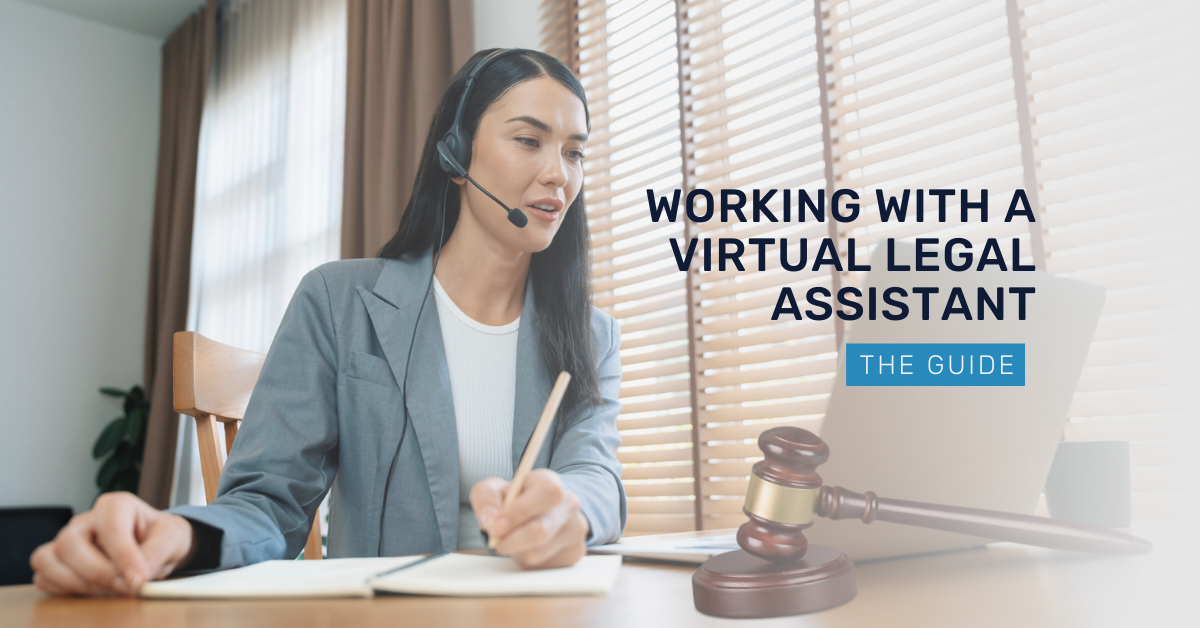Your inbox explodes with emails, deadlines loom large, and you’re drowning in paperwork. Does this scenario sound all too familiar? In today’s demanding legal world, lawyers and law firms face constant pressure to manage heavy workloads while maintaining high standards.
There’s good news! A revolutionary solution exists: the virtual legal assistant (VLA). Think of a highly-skilled, experienced professional dedicated to supporting your practice remotely. VLAs offer a wide range of services, from scheduling appointments and organizing documents to conducting legal research and handling client communication.
This guide will equip you with everything you need to know about working with a VLA. We’ll explore the process of finding the perfect fit, setting clear expectations, and fostering a successful collaboration.
Finding the Right Virtual Legal Assistant

Identify Your Needs
The first step is to determine the types of tasks you need assistance with. Consider areas like:
- Calendar management and appointment scheduling
- Document review and preparation
- Legal research and case management
- Client communication and intake
- E-discovery and data management
Match Skills and Experience
Once you know your needs, look for a VLA with relevant skills and experience. Here are some key qualities to consider:
- Legal knowledge and experience: While not essential for all tasks, some legal understanding can be beneficial.
- Strong organizational and communication skills: VLAs need to be highly organized and detail-oriented to manage multiple tasks effectively. Excellent written and verbal communication are crucial for client interaction and accurate information relay.
- Technical proficiency: Familiarity with legal software, research databases, and other relevant technology is a plus.
- Time management and self-motivation: As remote workers, VLAs need to manage their time effectively and be self-motivated to complete tasks independently.
Find Qualified Candidates
Several resources can help you find qualified VLAs:
- Online job boards: Platforms like Indeed or specialized legal job boards can connect you with VLA candidates.
- Virtual assistant service companies: These companies typically vet and train their VLAs and can match you with someone who meets your specific needs.
- Referrals: Ask colleagues, legal associations, or your network for recommendations on qualified VLAs.
The Interview Process
Treat the interview process with the same seriousness you would for any other position. Ask specific questions to assess skills, experience, and cultural fit. Consider conducting a trial period to allow the VLA to demonstrate their abilities before committing to a long-term arrangement.
Building a Successful Working Relationship

Finding the right VLA is just the first step. To unlock the full potential of this partnership, fostering a strong working relationship is crucial. Here’s how to cultivate a collaborative environment that empowers your VLA and optimizes your team’s success:
Clear Communication and Expectations
Once you’ve hired a VLA, set clear expectations from the outset. Define their role, responsibilities, and preferred communication methods (email, phone calls, project management software). Ensure they have access to necessary resources, including legal databases, templates, and software.
Ongoing Feedback and Training
Provide regular feedback to your VLA so they can understand their strengths and areas for improvement. Offer training opportunities to help them develop their legal knowledge and technological skills.
Utilize Technology
Utilize project management tools and online collaboration platforms to streamline communication, assign tasks, and track progress. Cloud-based document sharing allows for remote access and real-time editing, improving efficiency
Security and Confidentiality

Working with a VLA offers numerous advantages, but it also introduces new considerations regarding data security and client confidentiality. To ensure your peace of mind and maintain the highest ethical standards, here are essential strategies to implement:
Data Security Protocols
Data security is a paramount concern when working with a VLA. Implement robust data security protocols to protect sensitive information. Use secure cloud storage solutions with encryption, and ensure that the VLA follows best practices for data protection. Regularly update passwords and use multi-factor authentication for added security.
Client Confidentiality Agreements
Confidentiality is the cornerstone of any legal practice. Ensure that your VLA signs a comprehensive confidentiality agreement before commencing work. This agreement should outline their obligations to protect client information and the consequences of any breaches. Regularly review and update these agreements to address any changes in legal requirements or technology.
Secure Communication Channels
Using secure communication channels is essential to protect sensitive information. Avoid using unsecured email or messaging services for sharing confidential documents.
Instead, use encrypted communication tools and secure file-sharing platforms. Train your VLA on the importance of using these tools and regularly review their compliance with security protocols.
Conclusion
Working with a Virtual Legal Assistant offers numerous benefits that can significantly enhance the efficiency and effectiveness of your legal practice. VLAs provide cost-effective, flexible, and specialized support that can be tailored to meet the unique needs of your firm. By following the steps above, you can maximize the advantages of this modern legal support solution.
Want to transform your practice and achieve greater success? Don’t just hire any VLA – partner with the experts at Office Admin Help! We specialize in connecting legal professionals with highly qualified virtual legal assistants who possess the skills and experience to seamlessly integrate into your team.
Stop feeling overwhelmed and start achieving more! Contact Office Admin Help today to discuss your VLA needs and discover how we can help you streamline your practice and unlock your full potential.




